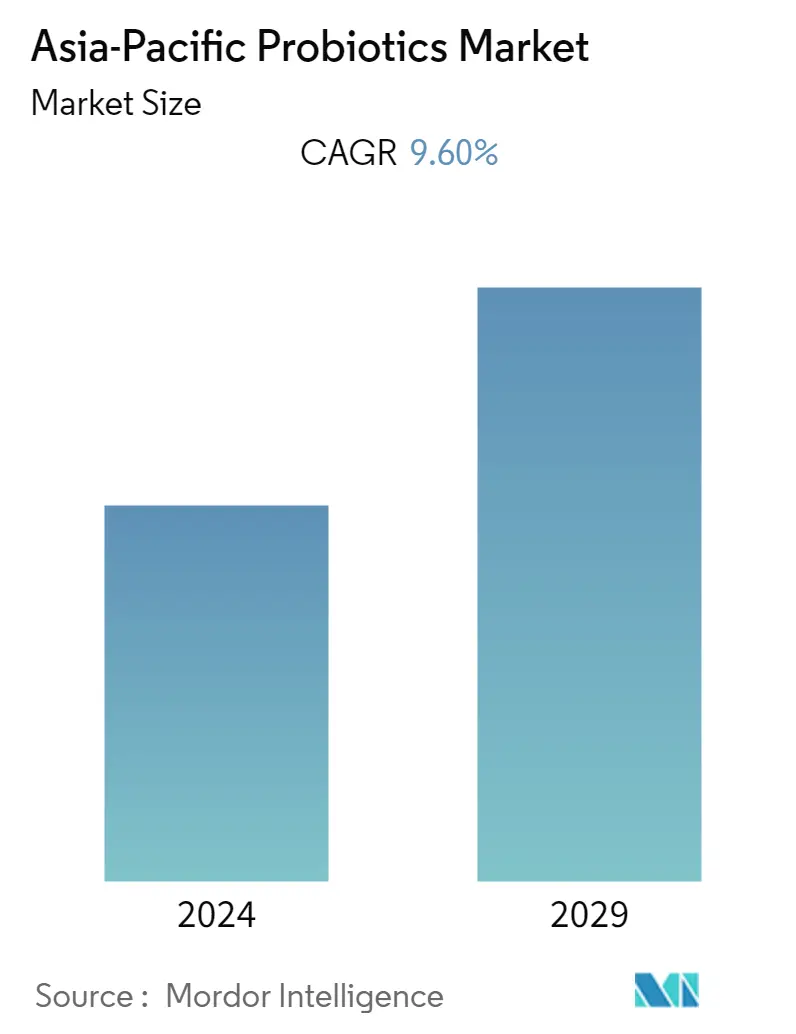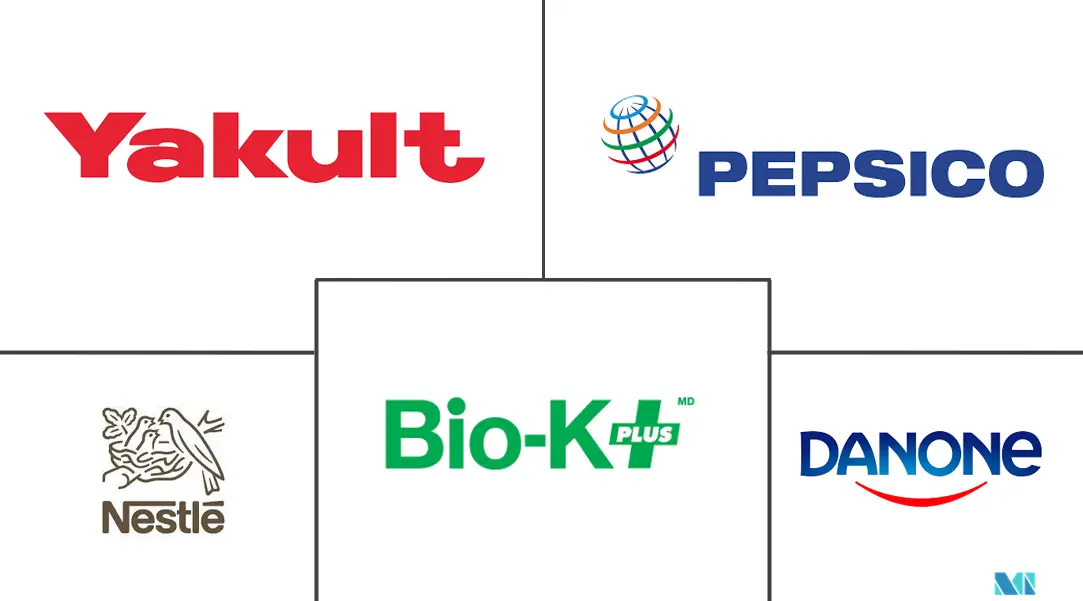Market Size of Asia-Pacific Probiotics Industry

| Study Period | 2019 - 2029 |
| Base Year For Estimation | 2023 |
| Forecast Data Period | 2024 - 2029 |
| Historical Data Period | 2019 - 2022 |
| CAGR | 9.60 % |
| Market Concentration | Low |
Major Players
*Disclaimer: Major Players sorted in no particular order |
APAC Probiotic Market Analysis
The Asia-Pacific probiotics market is projected to witness a CAGR of 9.6% over the next five years.
The market is majorly driven by the robust demand for health-based products, like probiotics, among consumers, especially the younger generations. Probiotics are part of functional foods and beverages and are known for improving gut functionality, along with other benefits, including immunity boost. Various health benefits of probiotic foods are driving consumers in the region toward the consumption of such foods and beverages. Probiotics are made of good live bacteria and/or yeasts that naturally live in your body which help in digesting food, creating vitamins, and the breakdown and absorbing medications, among many others. Additionally, increasing acidity, stomach and gut issues, and indigestion problems among people in the region are increasing the demand for such probiotics-incorporated foods. For instance, according to GOQii, a large-scale survey conducted across India in 2021 resulted that about 30% of female respondents reported acidity and indigestion problems, whereas about 29% of male respondents had gut-related problems that year.
Moreover, a growing number of customers in the region are turning to beverages that do more than just satisfy their thirst, and this is creating a strong need for functional beverages to meet their demands, in addition to naturally sourced, balanced, and nutritious meals. This growing trend of healthier, enhanced drinks has created a new opportunity for brands or start-ups to develop products that nourish as well as refresh and hydrate. For instance, a new start-up in India called Ginger Rage offers probiotic products like Kombucha, which claims to be low in calories, a cocktail mixer, and is gut-friendly and an immunity booster. The company is also offering all of its products through its online retail store and other social media platforms. Such innovations and diversity in the products being offered in the region are expected to further boost the market's growth during the forecast period.
APAC Probiotic Industry Segmentation
Probiotics are a combination of beneficial bacteria and yeasts that help humans and animals maintain intestinal microbial balance.
The Asia-Pacific Probiotics Market is Segmented by Product Type (Probiotic Foods, Probiotic Drinks, and Dietary Supplements), Distribution Channel (Supermarkets/Hypermarkets, Pharmacies and Health Stores, Convenience Stores, Online Retail Stores, and Other Distribution Channels), and Geography (India, China, Japan, South Korea, Australia, Rest of Asia-Pacific). The report offers market size and values in (USD million) for the above-mentioned segments.
| Type | ||||||
| ||||||
| ||||||
| Dietary Supplements |
| Distribution Channel | |
| Supermarkets/Hypermarkets | |
| Convenience Stores | |
| Pharmacies and Drug Stores | |
| Online Retail Stores | |
| Other Distribution Channels |
| Geography | |
| China | |
| Japan | |
| India | |
| South Korea | |
| Australia | |
| Rest of Asia-Pacific |
Asia-Pacific Probiotics Market Size Summary
The Asia-Pacific probiotics market is experiencing significant growth, driven by a strong consumer demand for health-oriented products, particularly among younger demographics. Probiotics, which are integral to functional foods and beverages, are gaining popularity due to their benefits in enhancing gut health and boosting immunity. The increasing prevalence of digestive issues such as acidity and indigestion is further propelling the demand for probiotic-infused foods and beverages. This trend is creating opportunities for brands and startups to innovate and offer products that not only refresh but also provide nutritional benefits. The market is characterized by a diverse range of offerings, including probiotic beverages like Kombucha, which cater to the growing consumer preference for healthier drink options.
In the region, the probiotics market is marked by a strong focus on digestive health supplements, with a notable consumption among millennials who are increasingly aware of health and wellness. The market is further bolstered by advancements in technology and product development, particularly in countries like Japan, where scientific research supports the creation of effective probiotic products. Major players such as Yakult, Danone, and Nestlé dominate the market, leveraging strategies like product innovation to expand their reach. The fragmented nature of the market sees continuous introduction of new products, such as probiotic drinks targeted at specific health benefits, which are contributing to the overall growth and diversification of the probiotics market in the Asia-Pacific region.
Asia-Pacific Probiotics Market Size - Table of Contents
-
1. MARKET DYNAMICS
-
1.1 Market Drivers
-
1.2 Market Restraints
-
1.3 Porter's Five Forces Analysis
-
1.3.1 Threat of New Entrants
-
1.3.2 Bargaining Power of Buyers/Consumers
-
1.3.3 Bargaining Power of Suppliers
-
1.3.4 Threat of Substitute Products
-
1.3.5 Intensity of Competitive Rivalry
-
-
-
2. MARKET SEGMENTATION
-
2.1 Type
-
2.1.1 Probiotic Foods
-
2.1.1.1 Yogurt
-
2.1.1.2 Bakery/Breakfast Cereals
-
2.1.1.3 Baby Food and Infant Formula
-
2.1.1.4 Other Probiotic Foods
-
-
2.1.2 Probiotic Drinks
-
2.1.2.1 Fruit-based Probiotic Drinks
-
2.1.2.2 Dairy-based Probiotic Drinks
-
-
2.1.3 Dietary Supplements
-
-
2.2 Distribution Channel
-
2.2.1 Supermarkets/Hypermarkets
-
2.2.2 Convenience Stores
-
2.2.3 Pharmacies and Drug Stores
-
2.2.4 Online Retail Stores
-
2.2.5 Other Distribution Channels
-
-
2.3 Geography
-
2.3.1 China
-
2.3.2 Japan
-
2.3.3 India
-
2.3.4 South Korea
-
2.3.5 Australia
-
2.3.6 Rest of Asia-Pacific
-
-
Asia-Pacific Probiotics Market Size FAQs
What is the current Asia-Pacific Probiotics Market size?
The Asia-Pacific Probiotics Market is projected to register a CAGR of 9.60% during the forecast period (2024-2029)
Who are the key players in Asia-Pacific Probiotics Market?
PepsiCo Inc., Danone SA, Yakult Honsha Co. Ltd, Nestle SA and Bio-k Plus International are the major companies operating in the Asia-Pacific Probiotics Market.

